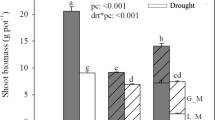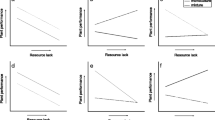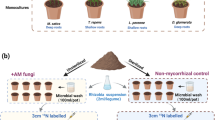Abstract
Background and aims
We investigated whether spatial differences in belowground niches between shallow- and deep-rooted species result in increased resource uptake and drought resistance in agricultural grassland communities.
Material and methods
We injected the tracers 15N and rubidium (Rb) into the soil and measured tracer uptake from 5 and 35 cm soil depth in monocultures and mixtures containing shallow-rooted (Lolium perenne, non-legume; Trifolium repens, legume) and deep-rooted (Cichorium intybus, non-legume; Trifolium pratense, legume) species, grown under drought or control conditions.
Results
Deep-rooted species had a higher proportional uptake of both tracers from 35 cm soil depth than shallow-rooted species (p < 0.001). Under drought conditions, all species enhanced their proportional tracer uptake from the deeper soil layer (p < 0.004) and species with a high proportional 15N uptake from the deeper soil layer were more drought resistant. Total community uptake of Rb was significantly higher in mixed communities than monocultures (p < 0.007); however, this diversity effect was the result of mixing legumes with non-legumes and not the result of mixing deep- with shallow-rooted species.
Conclusions
Clear evidence for spatial niche differences in resource uptake between shallow- and deep-rooted species did not translate into increased resource uptake in mixtures. Resource uptake from deeper soil layers was found to contribute to adaptation and resistance to drought stress.






Similar content being viewed by others
References
Asbjornsen H, Shepherd G, Helmers M, Mora G (2008) Seasonal patterns in depth of water uptake under contrasting annual and perennial systems in the Corn Belt Region of the Midwestern U.S. Plant Soil 308:69–92
Berendse F (1982) Competition between plant-populations with different rooting depths. 3. Field experiments. Oecologia 53:50–55
Black A, Laidlaw A, Moot D, O’Kiely P (2009) Comparative growth and management of white and red clovers. Ir J Agric Food Res 48:149–166
Brown H, Moot D, Pollock K (2003) Long term growth rates and water extraction patterns of dryland chicory, lucerne and red clover. Legumes for dryland pastures. Grassl Res Pract Ser 11:91–99
Cardinale BJ et al (2007) Impacts of plant diversity on biomass production increase through time because of species complementarity. PNAS 104:18123–18128
Chaves MM, Maroco JP, Pereira JS (2003) Understanding plant responses to drought - from genes to the whole plant. Funct Plant Biol 30:239–264
Christensen JH, Christensen OB (2003) Climate modelling: severe summertime flooding in Europe. Nature 421:805–806
De Boeck HJ, Verbeeck H (2011) Drought-associated changes in climate and their relevance for ecosystem experiments and models. Biogeosciences 8:1121–1130
Draper NR, Smith H (1998) Applied regression analysis, 3rd edn. Wiley, New York
Duru M, Ducrocq H (1996) A nitrogen and phosphorus herbage nutrient index as a tool for assessing the effect of N and P supply on the dry matter yield of permanent pastures. Nutr Cycl Agroecosyst 47:59–69
Finn JA et al (2013) Ecosystem function enhanced by combining four functional types of plant species in intensively managed grassland mixtures: a 3-year continental-scale field experiment. J Appl Ecol 50:365–375
Garwood EA, Sinclair J (1979) Use of water by six grass species. 2. Root distribution and use of soil water. J Agric Sci 93:25–35
Gilgen AK, Buchmann N (2009) Response of temperate grasslands at different altitudes to simulated summer drought differed but scaled with annual precipitation. Biogeosciences 6:2525–2539
Godfray HCJ et al (2010) Food security: the challenge of feeding 9 billion people. Science 327:812–818
Grieu P, Lucero D, Ardiani R, Ehleringer J (2001) The mean depth of soil water uptake by two temperate grassland species over time subjected to mild soil water deficit and competitive association. Plant Soil 230: 197–209
Grime JP, Brown VK, Thompson K, Masters GJ, Hillier SH, Clarke IP, Askew AP, Corker D, Kielty JP (2000) The response of two contrasting limestone grasslands to simulated climate change. Science 289:762–765
Hector A, Dobson K, Minns A, Bazeley-White E, Lawton JH (2001) Community diversity and invasion resistance: an experimental test in a grassland ecosystem and a review of comparable studies. Ecol Res 16:819–831
Hoekstra NJ, Finn JA, Buchmann N, Gockele A, Landert L, Prill N, Scherer-Lorenzen M, Lüscher A (2014a) Methodological tests of the use of trace elements as tracers to assess root activity. Plant Soil 380:265–283
Hoekstra NJ, Finn JA, Hofer D, Lüscher A (2014b) The effect of drought and interspecific interactions on the depth of water uptake in deep- and shallow-rooting grassland species as determined by δ18O natural abundance. Biogeosciences 11:4493–4506
Hooper DU et al (2005) Effects of biodiversity on ecosystem functioning: a consensus of current knowledge. Ecol Monogr 75:3–35
IPCC (2013) Climate Change 2013: the physical science basis, contribution of working group I to the fifth assessment report of the intergovernmental panel on climate change. In: Stocker TF, Qin D, Plattner GK, Tignor M, Allen SK, Boschung J, Nauels A, Xia Y, Bex V and Midgley PM (eds.). Cambridge University Press, Cambridge, United Kingdom and New York, NY, USA, 1535 pp
Kahmen A, Perner J, Buchmann N (2005) Diversity-dependent productivity in semi-natural grasslands following climate perturbations. Funct Ecol 19:594–601
Kahmen A, Renker C, Unsicker SB, Buchmann N (2006) Niche complementarity for nitrogen: an explanation for the biodiversity and ecosystem functioning relationship? Ecology 87:1244–1255
Kennedy TA, Naeem S, Howe KM, Knops JMH, Tilman D, Reich P (2002) Biodiversity as a barrier to ecological invasion. Nature 417:636–638
Kenward MG, Roger JH (1997) Small sample inference for fixed effects from restricted maximum likelihood. Biometrics 53:983–997
Kirwan L, Connolly J, Finn JA, Brophy C, Lüscher A, Nyfeler D, Sebastia MT (2009) Diversity-interaction modeling: estimating contributions of species identities and interactions to ecosystem function. Ecology 90:2032–2038
Kulmatiski A, Beard KH (2013) Root niche partitioning among grasses, saplings, and trees measured using a tracer technique. Oecologia 171:25–37
Lehner B, Döll P, Alcamo J, Henrichs T, Kaspar F (2006) Estimating the impact of global change on flood and drought risks in Europe: a continental, integrated analysis. Clim Chang 75:273–299
Li D, Lanigan G, Humphreys J (2011) Measured and simulated nitrous oxide emissions from ryegrass- and ryegrass/white clover-based grasslands in a moist temperate climate. PLoS ONE 6, E26176
Lüscher A, Mueller-Harvey I, Soussana JF, Rees RM, Peyraud JL (2014) Potential of legume-based grassland-livestock systems in Europe: a review. Grass Forage Sci 69:206–228
Mamolos AP, Elisseou GK, Veresoglou DS (1995) Depth of root activity of coexisting grassland species in relation to N-addition and P-addition, measured using nonradioactive tracers. J Ecol 83:643–652
Mommer L et al (2010) Unveiling below-ground species abundance in a biodiversity experiment: a test of vertical niche differentiation among grassland species. J Ecol 98:1117–1127. doi:10.1111/j.1365-2745.2010.01702.x
Nyfeler D, Huguenin-Elie O, Suter M, Frossard E, Connolly J, Lüscher A (2009) Strong mixture effects among four species in fertilized agricultural grassland led to persistent and consistent transgressive overyielding. J Appl Ecol 46:683–691. doi:10.1111/j.1365-2664.2009.01653.x
Nyfeler D, Huguenin-Elie O, Suter M, Frossard E, Lüscher A (2011) Grass-legume mixtures can yield more nitrogen than legume pure stands due to mutual stimulation of nitrogen uptake from symbiotic and non-symbiotic sources. Agric Ecosyst Environ 140:155–163
Oelmann Y et al (2011) Plant diversity effects on aboveground and belowground N pools in temperate grassland ecosystems: development in the first 5 years after establishment. Global Biogeochemical Cycles 25, doi: 10.1029/2010GB003869
Peyraud JL, Delaby L (2008) Intensive grassland management with emphasis on N flows. Prod Anim 21:167–179
Pinheiro JC, Bates DM (2009) Mixed-effects models in S and S-Plus, 2nd edn. Springer, New York
Pirhofer-Walzl K, Eriksen J, Rasmussen J, Høgh-Jensen H, Søegaard K (2013) Effect of four plant species on soil 15N-access and herbage yield in temporary agricultural grasslands. Plant Soil 371:313–325
Prechsl UE, Burri S, Gilgen AK, Kahmen A, Buchmann N (2014) No shift to a deeper water uptake depth in response to summer drought of two lowland and sub-alpine C3-grasslands in Switzerland. Oecologia. doi:10.1007/s00442-014-3092-6
R Development Core Team (2014) R: A language and environment for statistical computing, 2.12.2 edn. R Development Core Team: Vienna, Austria
Rockström J et al (2009) A safe operating space for humanity. Nature 461:472–475
Sanderson MA, Skinner RH, Barker DJ, Edwards GR, Tracy BF, Wedin DA (2004) Plant species diversity and management of temperate forage and grazing land ecosystems. Crop Sci 44:1132–1144
Schär C, Vidale PL, Lüthi D, Frei C, Häberli C, Liniger MA, Appenzeller C (2004) The role of increasing temperature variability in European summer heatwaves. Nature 427:332–336
Sharp R, Davies W (1985) Root growth and water uptake by maize plants in drying soil. J Exp Bot 36:1441–1456
Tilman D, Wedin D, Knops J (1996) Productivity and sustainability influenced by biodiversity in grassland ecosystems. Nature 379:718–720
Tilman D, Knops J, Wedin D, Reich P (2002) Plant diversity and composition: effects on productivity and nutrient dynamics of experimental grasslands. In: Loreau M, Naeem S, Inchausti P (eds) Biodiversity and Ecosystem functioning, Synthesis and perpectives. Oxford University Press, London, pp 21–35
Vicca S, Gilgen A, Camino Serrano M, Dreesen F, Dukes J, Estiarte M, Gray S., Guidolotti G, Hoeppner S, Leakey A (2012) Urgent need for a common metric to make precipitation manipulation experiments comparable. New Phytol 195: 518–522
Vogel A, Scherer-Lorenzen M, Weigelt A (2012) Grassland resistance and resilience after drought depends on management intensity and species richness. PLoS ONE 7:e36992
von Felten S, Schmid B (2008) Complementarity among species in horizontal versus vertical rooting space. J Plant Ecol 1:33–41
von Felten S, Hector A, Buchmann N, Niklaus PA, Schmid B, Scherer-Lorenzen M (2009) Belowground nitrogen partitioning in experimental grassland plant communities of varying species richness. Ecology 90:1389–1399
von Felten S, Niklaus PA, Scherer-Lorenzen M, Hector A, Buchmann N (2012) Do grassland plant communities profit from N partitioning by soil depth? Ecology 93:2386–2396
Acknowledgments
N.J.H. was funded by the Irish Research Council, co-funded by Marie Curie Actions under FP7. The field experiment was supported by the European Community’s Seventh Framework Programme (FP7/2007-2013) under the grant agreements FP7-244983 (MultiSward) and FP7-266018 (AnimalChange). The authors would like to thank Daniel Hofer, Cornel Stutz, Rafael Gago, Rita Lopez, Andreas Kundela, Diane Bürge and Johanna Keita for their assistance with field work and tracer analysis.
Author information
Authors and Affiliations
Corresponding author
Additional information
Responsible Editor: Hans Lambers.
Electronic supplementary material
Below is the link to the electronic supplementary material.
ESM 1
(PDF 585 KB)
Rights and permissions
About this article
Cite this article
Hoekstra, N.J., Suter, M., Finn, J.A. et al. Do belowground vertical niche differences between deep- and shallow-rooted species enhance resource uptake and drought resistance in grassland mixtures?. Plant Soil 394, 21–34 (2015). https://doi.org/10.1007/s11104-014-2352-x
Received:
Accepted:
Published:
Issue Date:
DOI: https://doi.org/10.1007/s11104-014-2352-x




